With numerous regions encompassing coastal areas, basins, plateaus, mountains, and more, the ‘Beaver State’ of Oregon is an excellent place to spend a little time birding. Today we are going to explore that subject and give you some information on some of the species which you can see here and let you know what they like to eat, where they like to hide, and more! Let’s talk about the popular backyard birds of Oregon!
3 Categories – 500 Birds
Oregon is home to a whopping 500 species of birds and that should keep the resident birders both well-envied and happy. While we can’t list all of them in the space we have allotted, we CAN provide you with a sampling and divide them up like this:
- Year-round Resident birds
- Birds of Spring, Summer, and Early Fall
- Fall and Winter Birds
By using this method you’ll know the best times to be on the lookout for the birds which we have listed and with a little preparation of your backyard feeder you might just be able to lure in a few new feathered friends. First we’ll start with the full-time residents.
Oregon’s Year-round Resident birds
These birds love Oregon unconditionally and would never leave her, be the season hot, warm, or chilly-cold. Look for these birds at any time of the year:
- Yellow-rumped Warbler
- California Scrub-Jay
- Black-capped Chickadee
- Dark-eyed Junco
- American Robin
Yellow-rumped Warbler – Setophaga coronata

Coloration and Markings: Yellow-rumped Warblers have beautiful coloration. They have gray backs, wings, and long, gray black-tipped tails. The wings show some wide, vertical white lines at mid-wing and there is some black dotting on the back. The breast and underbelly of this bird has heavy black coloration in the form of a ‘vest’ with white showing in the center, which increases in width as you approach the underbelly and the black ‘vest’ thins out. This bird has a distinctive yellow patch under each wing and facially, this bird has an almost completely velvet gray face with the exception of a small and vibrant yellow bib and a noticeable eyering which is divided at the central portion of the eyes. This bird has a short, straight black bill.
Size: These birds measure in at 4.5 – 5.5 inches with wingspans of 7.5 to 9.1 inches.
Habitat: When it’s warm, you’ll find these Warblers most often in the edges and open portions of coniferous and, occasionally, in deciduous forests. They are fond of meadows and copses and will visit backyards as long as there is a bit of space to make them comfortable.
Diet: These birds love a few things, such as suet, Black Oil Sunflower seeds, raisins, and chunky peanut butter. Leave out any of these or a small selection of them and you might just tempt this bird’s tummy.
California Scrub-Jay – Aphelocoma californica

Coloration and Markings: California Scrub Jays have white coloration on their back that extends slightly into their long, mostly-blue wings. They have long, blue tails and a white breast and underbelly, with the breast showing wide, blue lines coming down from the head as if the bird were wearing a torque or a blue aviation hat. Facially, the white from the breast carries up until under the bill, while stretching horizontally to mid-cheek level. Te face is largely blue except there is gray at the cheek and under the eyes and a distinct, curved white ‘eyebrow’ that is hard to miss These birds have stout, medium-sized gray bills with a noticeable curve to them.
Size: These birds measure in at 11 – 11.8 inches in length with wingspans of 15.3 inches.
Habitat: These birds love the open woods, especially Oak copses, chaparrals, orchards, and backyards where there is a lot of space and a few trees.
Diet: These birds love crunchy bugs but they eat a number of things. It’s best to go with fruit and nuts, so try some chopped apples and peanuts or combine chopped apples in a mix with crunchy peanut butter for a yummy, yet effective treat-lure.
Black-capped Chickadee – Poecile atricapillus
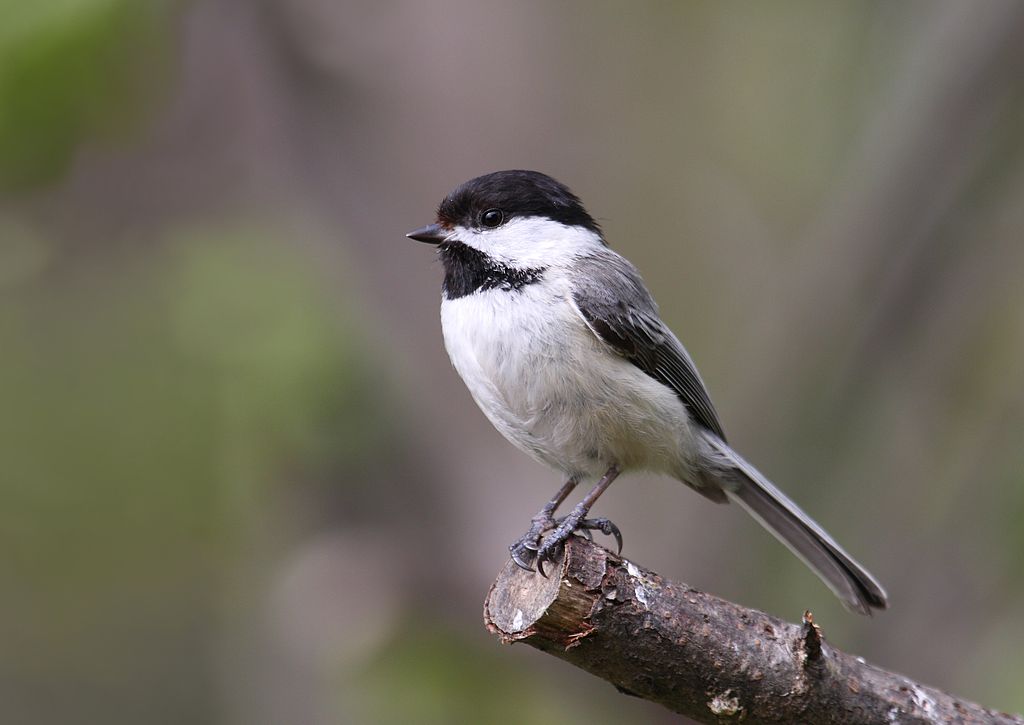
Coloration and Markings: The Black-capped Chickadee has a gray back, with short, gray white-edged wings and a medium-sized gray tail. The tail is also edged in white and the breast and underbelly of this bird are a bright white as well. This bird has a white face with a small, black bib and a large, black cap, that extends down to just under the eye and then travels diagonally up to the back of the head. This bird has a tiny, straight black bill.
Size: These birds measure 4.7 – 5.9 inches from head to tail with wingspans of 6.3 to 8.3 inches.
Habitat: Overgrown fields, marshes with a lot of vegetation, and a forest’s edge with shrubs… if there is cover around, preferably with some trees also present, then the Black-capped Chickadee feels at home.
Diet: Try adding chunky peanut butter, suet, and Blueberries to your feeder when you see one of these Chickadees nearby. If they notice then you might just make that bird a happy one.
Dark-eyed Junco – Junco hyemalis

Coloration and Markings: Dark-eyed Juncos have some variation in their plumage from region to region, but most commonly they have a smooth, gray or brown back, with medium-length, gray or brown wings and a long tail of the same color, with white outer feathers.The breast is white, heavily flanked with gray which lessens in width as it approaches the underbelly and disappearing completely at the white rump. The even coloration when the bird is rest makes it look as if someone gave the bird a quick dunk in white paint. Facially, this bird has a gray/brown face, sometimes with a dim eyeline that consists of lighter colored gray which travels behind the eye and curls around to frame the cheek. This bird has a stout, conical pink bill.
Size: These birds measure in at 5.5 – 6.3 inches from tip to tail and have wingspans of 7.1 to 9.8 inches.
Habitat: When it’s warm outside these birds like to spend their time in partial to mostly coniferous forests. They range occasionally at this time but it really picks up in winter, when they are often seen at parks, orchards, backyards, and even weedy fields.
Diet: White Proso millet and hulled Black Oil Sunflower seeds are an easy mix for potentially getting the attention (and keeping it!) of a Dark-eyed Junco.
American Robin – Turdus migratorius
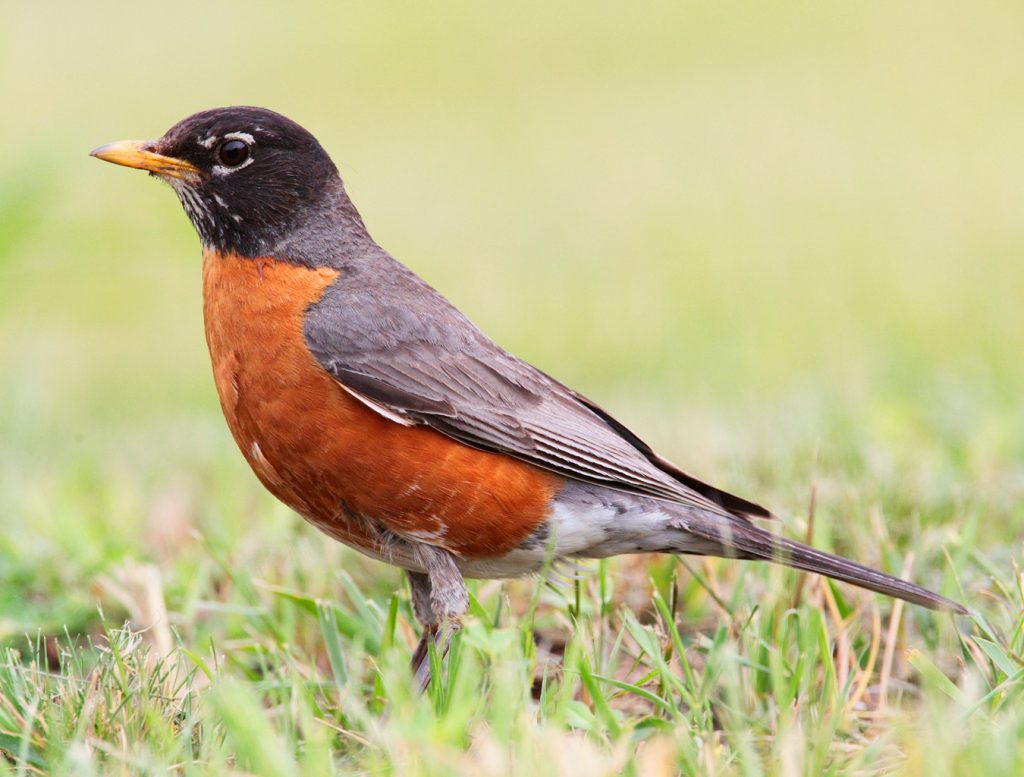
Coloration and Markings: American Robins are easy to identify. They have grayish brown backs and long wings with minute white edging on the feathers. Their long tails continue the coloration but it will be darker, with thin, white tips at the end, and white undersides. This white connects underneath and stops at this bird’s white rump. The beast and underbelly of this bird are orange to red-orange and facially, the Robin has a black head with a tiny amount of white under the bill and a distint, broke white eyering surrounding the eyes. This bird has a short, lightly curved yellow bill that sometimes displays a black spot at the tip. Females have the same color scheme but their colors are muted, providing less contrast while remaining distinctive.
Size: This bird measures in at 7.9 – 11 inches in length with a wingspan of 12.2 to 15.8 inches.
Habitat: These birds get around, spending their time in deciduous and Pine forests, as well as golf course, backyards, open fields, and gardens. They are more than happy to visit a well-stocked feeder.
Diet: Try leaving out a combination of shopped apples, Blueberries, and dried mealworms if you really want to spoil a visiting Robin. You’ll both be happy that you did!
Oregon’s Birds of Spring, Summer, and Early Fall
Shortly after Valentines you will start seeing signs of spring in Oregon and it’s a very colorful time. Hyacinths and cherry blossoms start blooming along with a number of other fauna and migratory birds start arriving in force. These birds may be seen starting in spring and tend to stay through to summer and fall before taking off to relocate. See if you can spot the following:
- American Goldfinch
- Chipping Sparrow
- Black-headed Grosbeak
- Violet-green Swallow
- Warbling Vireo
American Goldfinch – Spinus tristis

Coloration and Markings: The American Goldfinch shows that you don’t need a lot of ddifferent colors to stick out. They have bright yellow backs, with long, black wings and short black tails. The wings show a white mark at the top of the shoulder, as well as a white wingbar on each wing, and white vertical lines and other assorted white markings as you look down the wings and tail. They have a yellow breast and underbelly, with a white rump, and facially this bird keeps the body-yellow with one exception. It has a bold, black cap that goes from the middle of the head to the front of the small, conical, orange bill. Females have muted coloration, with yellow below and with the black displaying as more of an olive coloration. In the winter these birds go incognito, molting that yellow and going brown, but you’ll still notice the wing markings, dimmed though they are.
Size: These little birds measure in at 4.3 – 5.1 inches in length with wingspans of 7.5 to 8.7 inches.
Habitat: These birds like to forage in flood-prone areas as well as grassy fields. They do come to backyards so be ready for them!
Diet: Nyjer thistle and Black Oil Sunflower seeds are all you need to properly entertain the American Goldfinch.
Chipping Sparrow – Spizella passerina
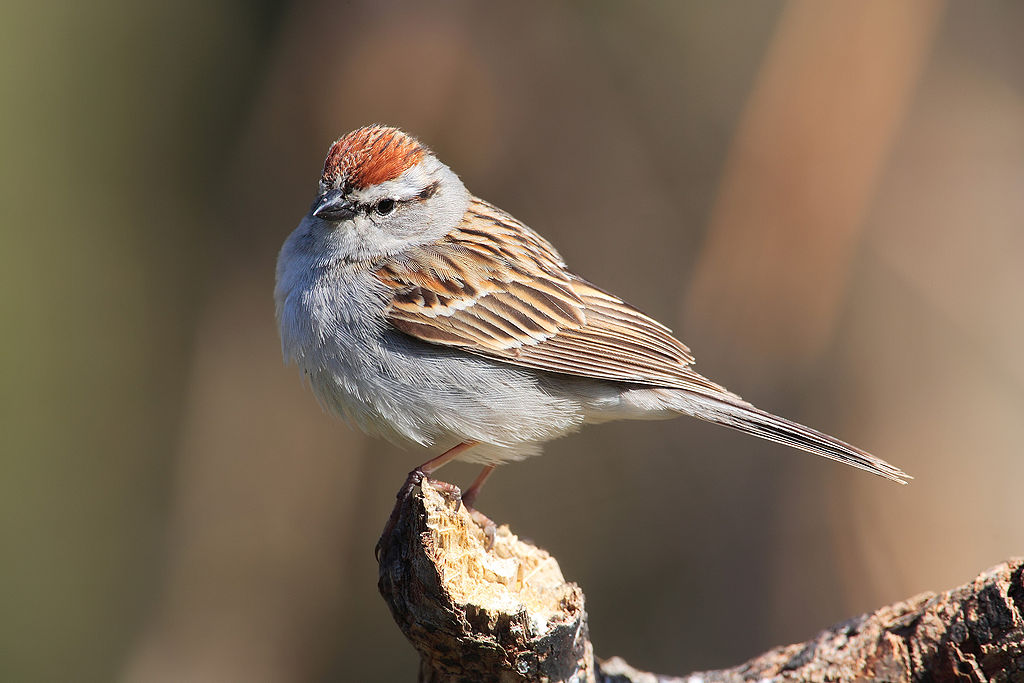
Coloration and Markings: Chipping Sparrows have a brownish-tan back, wings, and long, brownish tails. The wings have darker brown streaking to them as well as 2 thin, white lines of barely noticeable wingbars. A visible separation may be seen in the tail when the bird is at rest and the breast and underbelly of this bird are a chilly gray in color, with the underbelly being slighter lighter. Facially, this bird has a mostly white face. You will notice a thin, black eyeline that crosses the eye and before it meets the back of the head, it takes a quick v-shaped dip. A concentration of gray is also seen at the cheek and just under the eye, with half an eyering above the gray and under the eye. Some gray is also seen at the throat and the patterns make a white mustache line by outlining it. At the top of it’s head this bird has a rust-colored crown, with black at it’s termination towards the front of the face. Finally, this bird has a short, straight black bill. In the winter they are more buff-brown but the distinctive cap is still present, if a bit subdued, as is the black eyemark. This will allow you to easily identify them even when it is cold.
Size: These birds measure 4.7 – 5.9 inches from tip to tail and have wingspans of approximately 8.3 inches.
Habitat: These birds love open, wooded areas and so you might spot them in clearings, copses, or even wide areas of grass where there’s a tree or two. They are more than happy to visit backyard feeders so plan ahead, you might just get a visit!
Diet: Chipping Sparrows mostly eat insects but they sometimes go for fruit or seeds if they notice them. Try leaving out some dried mealworms with a couple of sides, like Black Oil Sunflower seeds and chopped apples or Nyjer thistle and Blueberries. If the Sparrow notices then it might just join you in the backyard for lunch.
Black-headed Grosbeak – Pheucticus melanocephalus

Coloration and Markings: Black-headed Grosbeaks have black backs with white markings. They have long, black wings with one wingbar and with assorted white patches and marks (though they are mostly black) and though you can’t see it until they fly, the undersides of their wings are yellow. This bird’s tail is long and dark on top while light gray on most of the underside, excepting that a wide black v-shape is present just before the white rump. A cinnamon or orange spot is present on the rump and the breast and underbelly of the grosbeak are cinnamon and orange colored. This orange continues up to outline the cheek and the remaining upper portion of the face is black, some of which drips minutely down into the lower orange as if it were wet paint. Finally, this bird has a large, lightly curved silver bill. Females and juveniles will be brown where the male is black and sometimes exhibit a bit of streaking on the breast. Their cinnamon-orange is muted but still quite distinctive so you won’t have a lot of trouble identifying this bird.
Size: About the size of a small Robin, these birds measure in at 7.1 – 7.5 inches long with wingspans at a length of approximately 12.6 inches.
Habitat: These birds hang out inside the woods and at its edges but they are also comfortable with open areas and areas with thickets, brambles, or shrubs. They eat a lot of different things so they will range just about anywhere, including a thoughtfully planned-out feeder.
Diet: A number of foods can attract the Black-headed Grosbeak. Some favorites include suet, cherries, shelled peanuts, and hulled Black Oil Sunflower seeds.
Violet-green Swallow – Tachycineta thalassina
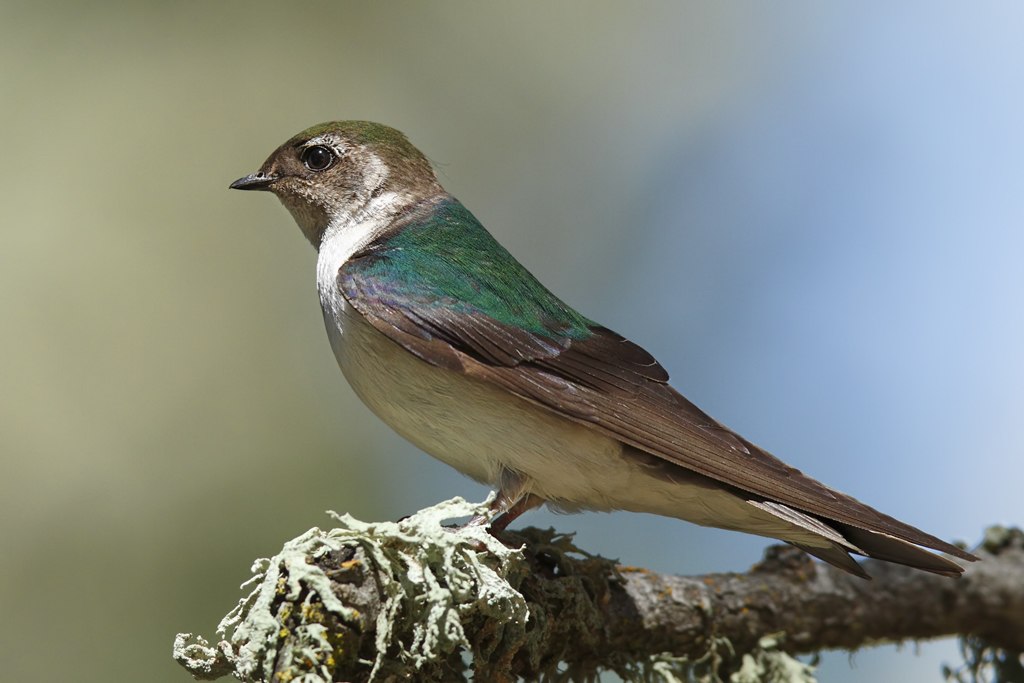
Coloration and Markings: Violet-green Swallows are a lovely sight, with emerald-green backs and shoulders while the remainder of their long wings will be a stunning violet or violet and gray color. They have medium length tails which have a slight fork to them and their breast and underbelly are a brilliant paper-white. This white continues up to the face where it is the primary color present, with an emerald green at the crown going from the bill to the top of the shoulders. This is more angular than a ‘curved-cap’ look, giving the white color on the face a rectangular look. These birds have tiny, straight black bills and the females tend to have dusky coloration in their cheeks. Juveniles, on the other hand, will tend to have grayish brown backs and crown coloration.
Size: These beautiful birds are quite small, measuring on average at 4.7 inches from tip to tail with wingspans of approximately 10.8 inches.
Habitat: These birds like to spend time inside deciduous and Evergreen forests but they also like meadows and copses. Look for trees with habitable hollows when you are hunting a glimpse of this Swallow. They also like water for catching insects, so check marshes and ponds as well.
Diet: These birds like to eat live food only, but you can sometimes lure them in with a nesting box. They are also attracted to dead trees in a yard.
Warbling Vireo – Vireo gilvus

Coloration and Markings: Simple but elegant, Warbling Vireos are not too hard to recognize. They have olive-gray backs, with long wings and a medium-length tail which are both the same color. The breast and underbelly of this bird tend to be white or off-white, with a healthy wash of yellow present at the vent and the sides. Facially, these birds will be olive-gray and a large white eyebrow line combined with a short white line below is present. An olive line also travels through the eye and this bird has a medium-length, straight gray bill. Around midsummer the coloration becomes simply gray above and white below, but if you have seen these birds a few times before then you’ll recognize them easily at any time of the year.
Size: These birds measure in at 4.7 – 5.1 inches in length and have wingspans of approximately 8.7 inches.
Habitat: These birds prefer deciduous forests but they are comfortable as well if there are some coniferous patches in the mix. These birds sometimes range out and will be more likely to visit your backyard if there are some tall trees present.
Diet: These birds mostly eat insects, but they do supplement their diet with berries in the summer and fall. Try some blueberries or chopped up cherries and you might have a little luck but no promises, as this bird is a little feeder-shy.
Oregon’s Fall and Winter Birds
With average lows approaching 18 degrees Fahrenheit, Oregon is just a little too chilly for some birds. Not the birds in this section, however, who simply put on a bit of extra plumage and tough it out. See if you can catch a glimpse of these winged, cold-defying birds:
- Golden-crowned Sparrow
- Spotted Towhee
- Anna’s Hummingbird
- Winter Wren
- Chestnut-backed Chickadee
Golden-crowned Sparrow – Zonotrichia atricapilla

Coloration and Markings: Golden-crowned Sparrows have streaked, brown backs and short wings and long, brown (or gray) tails. The breast and underbelly of this bird are a frosty gray, flanked with some faint brown coloration just under the wings, and facially they are gray up until mid-eye level. Above this, the Sparrow has black coloration to the top of the head with a chite stripe running down the center of the head which is bright yellow for 1/3 of it’s length in front of the bill. In winter, the yellow loses a bit of its luster and the black coloration is replaced with brown.
Size: These birds measure in at 5.9 – 7.1 inches in length with wingspans of approximately 10 inches.
Habitat: These birds love the forest edge and are fond of dense vegetation. You can find them in chaparrals, thickets, and areas with a lot of shrubs. They also aren’t afraid of the snow in winter.
Diet: These birds eat a lot of insects, however, they will sometimes visit a ground feeder for Nyjer thistle and Black Oil Sunflower seeds. They might raid your garden for vegetables as well (they seem to like cabbage), so consider yourself warned in advance.
Spotted Towhee – Pipilo maculatus

Coloration and Markings: Spotted Towhees have black backs and medium-length black wings with white spots. Typically 2 wingbar-type patterns composed of spots will be present and these birds have long, black tails with white corners. The breast and underbelly of this bird are snowy white with a heavy flanking of orange-brown on the sides and with black color making a v-shape at the top of the breast where it begins. This coloration continues up to an all-black head, making the lower coloration look beard-like, and you will notice striking red eyes in front of the Towhee’s stout, medium-length conical bill. This bill is generally black but sometimes grayish and females will be brownish-gray where the male is black.
Size: These birds measure in at 6.7 – 8.3 inches with wingspans of approximately 11 inches in length.
Habitat: These birds love dense vegetation, be it at the forest’s edge, an overgrown field, brambles, thickets, or areas with a lot of shrubs. They visit parks and backyards often, especially if you have a few bushes!
Diet: These birds love seeds, fruits, and the occasional grains. Give them some White Proso millet, Black Oil Sunflower seeds, Blueberries, or chopped apples and watch the fun!
Anna’s Hummingbird – Calypte anna

Coloration and Markings: Anna’s Hummingbirds are enchanting little Avians. They have gray and dark green backs, with greenish-yellow on their wings and gray from the tips to the shoulder. The breast is white at the top, turning yellowish and darkening to yellow green as it approaches the underbelly and terminates at the white rump. The throat and cheeks of the bird are ruby-red while the crown is almost brown starting at the back of the eyes and circling to just under the bill. The eye is outlined in a light tan coloration with a yellow spot behind and diagonal from the eye, with a vertical ruby line travelling through it to the top of the head. Lighter coloration travels down from the tan surrounding the eye and looks like a monocle when viewed from the side. These birds have long and thin black bills with a slight curve.
Size: These tiny little birds are approximately 3.9 inches in length with an average wingspan of 4.7 inches.
Habitat: These birds like areas with dense vegetation but also visit open areas such as the forest’s edge (especially if there is a stream or a river) and they aren’t shy about residential areas. They will be more than happy to visit if you’ve left them a little something.
Diet: Sugar-water in a Hummingbird feeder works just fine but you can also plant some Hummingbird Sage in your garden to attract them.
Winter Wren – Troglodytes hiemalis

Coloration and Markings: Winter Wrens are completely light brown and covered with tiny white spots on most of their bodies. These spots are especially concentrated on the back, short wings, and the perky, medium length tail. The breast is a lighter brown which darkens towards the underbelly and facially, this bird has a tan eyeline and often an underline as well, making a tan ‘V’ on the eye and the cap of this bird is brown with no spots. The throat should be spot-free as well and this bird has a straight, medium-length gray bill.
Size: These Wrens are tiny, measuring in at 3.1 – 4.7 inches in length and with wingspans of 4.7 to 6.3 inches.
Habitat: These birds love Evergreen and deciduous forests, where they often forage in fallen trees. They like water as well, so watch for them also next to ponds and streams.
Diet: These birds eat insects and sometimes even eat little fish! In the winter and fall they will sometimes supplement their diets with berries, so try leaving out some chopped cherries or whole blueberries for them and you might get their attentions.
Chestnut-backed Chickadee – Poecile rufescens

Coloration and Markings: Chestnut-backed Chickadees live up to their name. With chestnut to chestnut-and-red backs, short gray wings with white highlights and a thin white wingbar, and long, thin gray tails. The breast and underbelly of this bird are gray with chestnut flanking which thins out until it stops at the rump. Facially, these birds have white faces with a black bib and a big, black cap that goes down to just past the eyes. These birds have tiny, conical black bills. Flank color may vary regionally between chestnut and light gray.
Size: These little guys are 3.9 – 4.7 inches from head to tail and have wingspans of approximately 7.5 inches.
Habitat:
Diet: Try adding suet, Nyjer thistle, and Black Oil Sunflower seeds to your feeder menu and you might just attract a Chestnut-backed Chickadee!
Supporting cast (Other Backyard Birds of Oregon that might pay you a visit)
In order to stack the odds in your favor, we’ve added an extra section of year-round birds that we like to call our ‘supporting cast’. These birds may be seen at any time of the year and they are just as glamorous as our first set (they just don’t have good enough agents to get them into that section!). See if you can spot or lure one or more of these Supporting Cast members:
- Song Sparrow
- House Finch
- Northern Flicker
- Steller’s Jay
- American Crow
Song Sparrow – Melospiza melodia
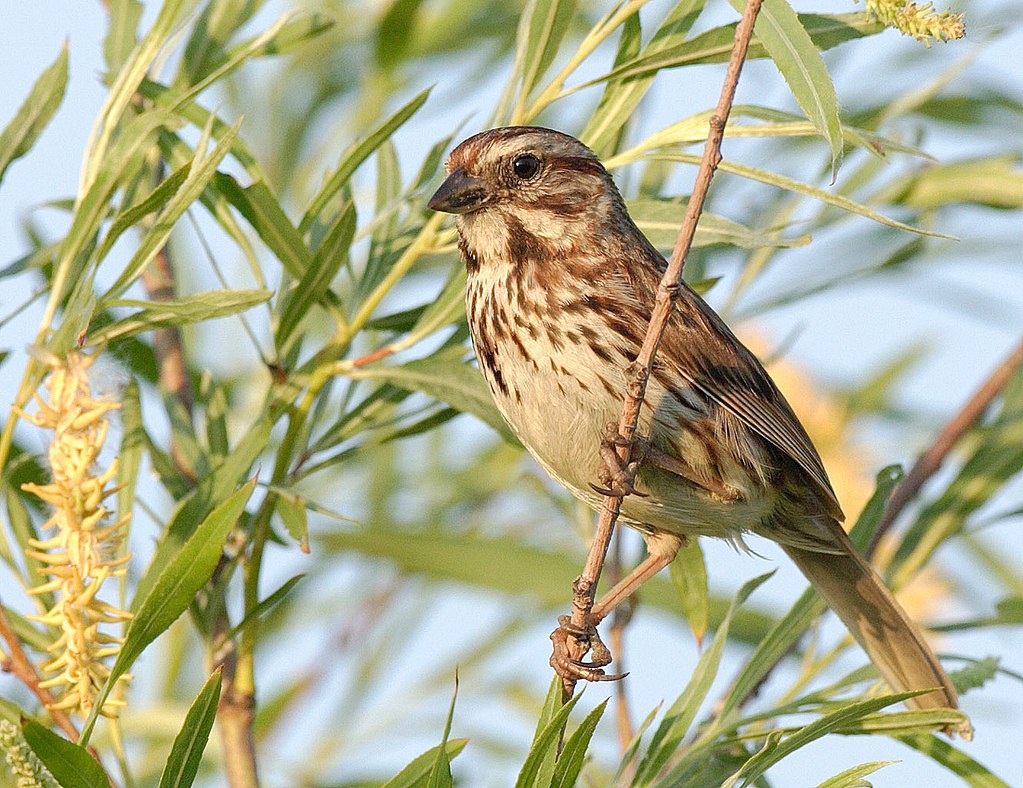
Coloration and Markings: Song Sparrows have a streaky brown back and short, streaky wings that are often a little gray at the tips. They have perky, fanning medium-length tails and their breast and underbelly is a brown-streaked white that lighten a bit at the rump. The face has 3 colors, showing mostly gray with a brown crown and a brown eyeline that starts behind the eyes. Front and center, under the bill, is a thin bit of white and this bird has a white mustache mark which is flanked by brown. These birds have small, conical gray bills.
Size: These birds measure in at 4.7 – 6.7 inches in length and have wingspans of 7.1 to 9.4 inches.
Habitat: These birds love any open area. You can see them in desert, marshes, the forest’s edge… basically if the area is roomy you might just spot a Song Sparrow but you will likely hear it first.
Diet: These birds mostly dine on insects but in the winter they start eating a lot of seeds. Try a mix of Nyjer thistle and Black Oil Sunflower seeds and be sure to use a ground feeder for this bird.
House Finch – Haemorhous mexicanus
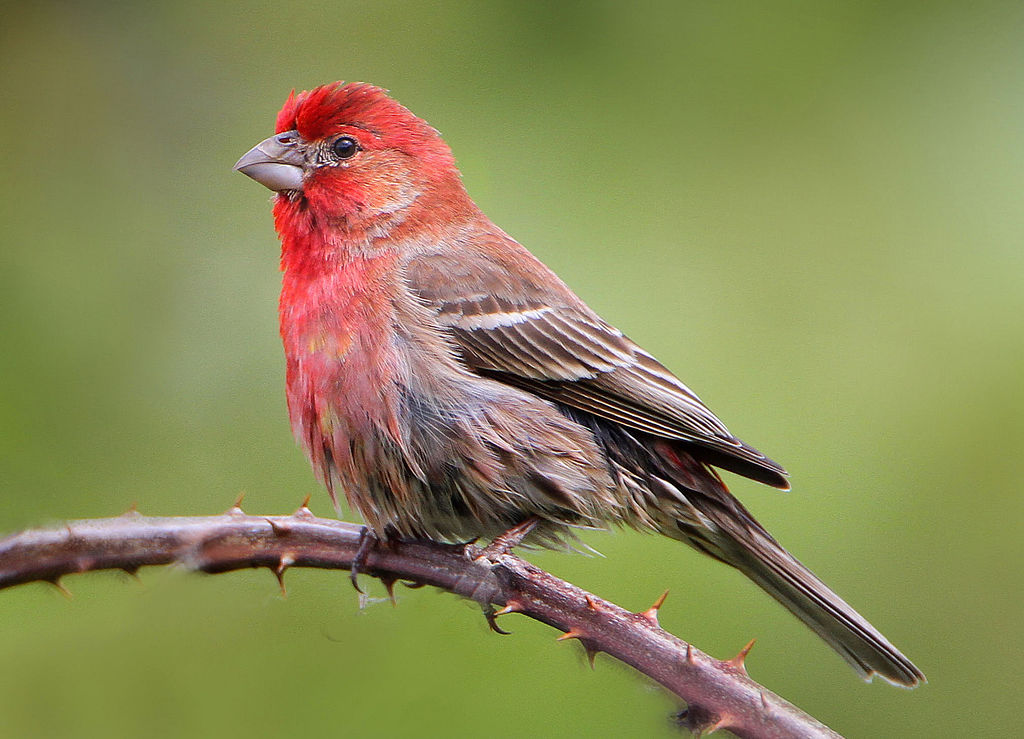
Coloration and Markings: House Finches have gray or brown backs, wings, and long tails with white on the outside. They will have heavy streaking on all and 2 white wingbars, thin but present, may be seen. The breast of this birds is heavily saturated with rosy-red color which turns into faint, red streaking at the underbelly. Facially, these birds are rosy red, with the thickest concentrations at the cheeks and forehead, and a gray eyeline that starts from the bill, passes through and underlines the eye, and then forks into one line that curves down to outline the cheek and another which goes towards the back of the head before splits and terminates. These birds have short, stout silver bills and the females are grayish-brown with a lot of streaking and no red coloration present. Their facial markings are much less pronounced.
Size: These birds measure in at 5.1 – 5.5 inches in length with wingspans of 7.9 to 9.8 inches.
Habitat: When not at the forest’s edge, these birds are frequently in the cities and town. You can find them in parks, on telephone lines, at farms, or simply visiting backyards. They are not shy about feeders so be sure to leave a little something out for them.
Diet: Nyjer thistle mixed with small Black Oil Sunflower seeds are a great way to attract these birds but be sure to stock up. They might bring a whole flock of friends!
Northern Flicker – Colaptes auratus
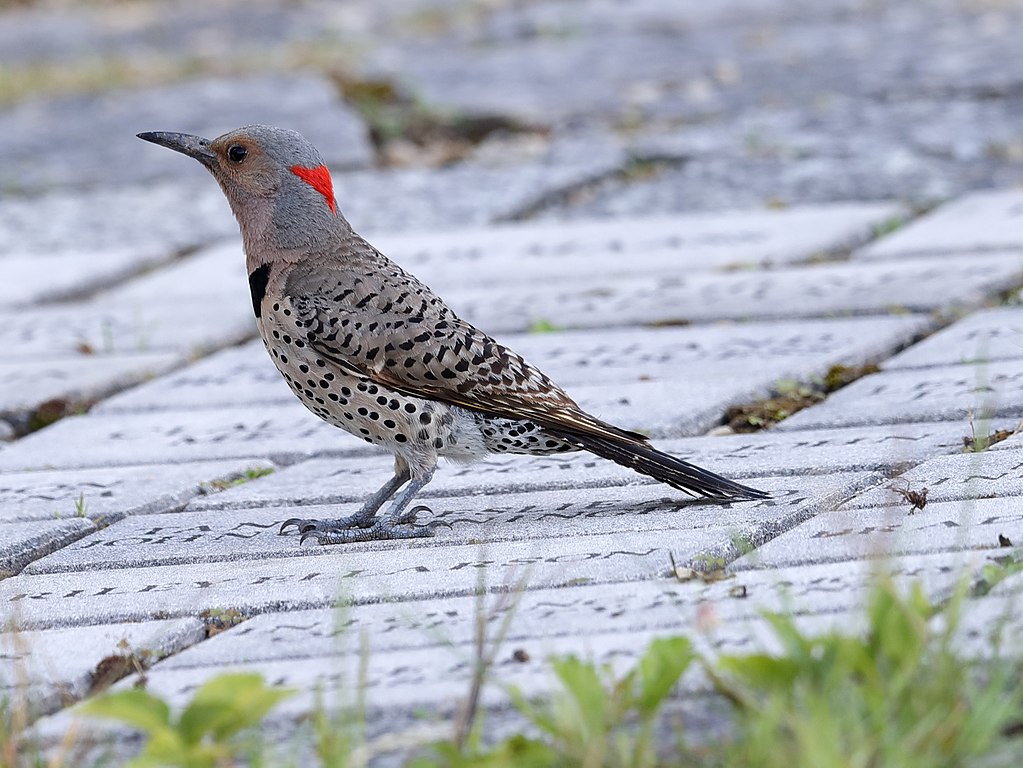
Coloration and Markings: Northern Flickers tend to be brown to gray with back, long wings, and long, pointy flared tails. On their wings you will see an assortment of black dots and lines and the undersides of the tail are going to be red or bright yellow, typically with black tips. The breast of this bird has a white-outlined black crescent at the top over a pattern of white or grayish-white with black spots. This bird has a long, gray neck and a smooth, gray face with a red stripe going from the bill to the cheek, a tan eyeline, and a thin, white eyering. This bird has a long, gray bill with a slight curve to it.
Size: Good-sized birds, Northern flickers measure in at 11 – 12.2 inches in length with wingspans of 16.5 to 20 inches.
Habitat: These birds love open areas, such as the forest’s edge, meadows, parks, and spacious backyards. Leave a little something out and you might just get a hungry visitor.
Diet: These birds eat mostly insects (being especially fond of ants) but sometimes indulge in fruits, nuts, and seeds. Leave out some Black Oil Sunflower seeds, chopped apples, and peanuts and you might just attract the Northern Flicker.
Steller’s Jay – Cyanocitta stelleri
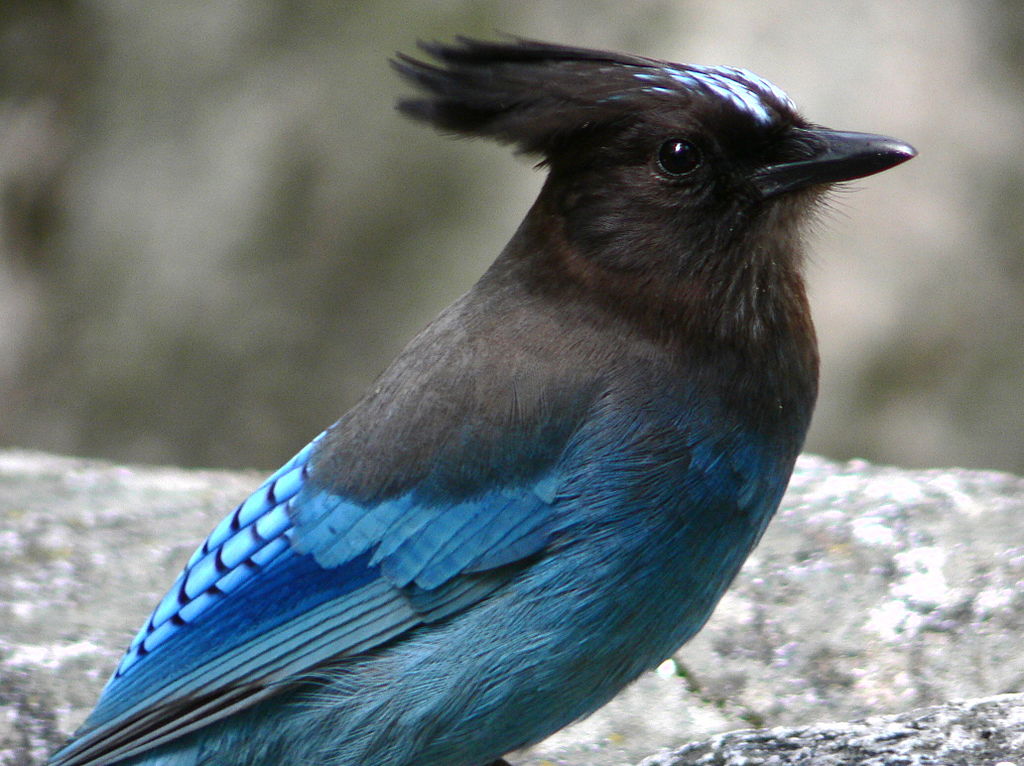
Coloration and Markings: A memorable sighting, the Stellar’s Jay has a gray to grayish-black back and shoulders, with deep blue wings that often gray at the tips. They have long, black-tipped blue tails and their breast has a charcoal black in the center and a flanking of dark blue that becomes completely blue towards the underbelly. Facially, this bird has a black head with a stunning crest and blue markings at the forehead just over a long, straight black bill.
Size: This bird is 11.8 – 13.4 inches from head to tail and has a wingspan of approximately 17.3 inches.
Habitat: When they aren’t spending time in Evergreen forests these birds are frequent visitors to parks and backyards.
Diet: Fruits, nuts, and berries are the way to go with the Stellar’s Jay. Try leaving out some peanuts, chopped apples, and whole Blueberries and you might soon get a visit from a happy Jay.
American Crow – Corvus brachyrhynchos

Coloration and Markings: Easy to identify and very clever, the American Crow is completely black. It has long wings and a long tail and facially you’ll also see a powerful, straight black bill.
Size: Crows are big birds, measuring in at 15.8 – 20.9 inches in length and with wingspans of 33.5 to 39.4 inches.
Habitat: These birds can be spotted in the woods, in fields, on roads, or simply on telephone wires in town as they survey the area below for their next meal.
Diet: These birds eat just about anything, raiding dumpsters for leftover human meals, picking fruits from gardens, or almost anything you put in a feeder. Peanuts are a favorite of theirs that you can leave out but even if you don’t, that Crow will probably check anyway to see what IS on the menu.
Oregon Bird Buffet
Creating a feeder to attract the most local birds without having to lay out an excess of varied foodstuffs is a bit of an art. Thankfully, the Oregon State University Extension has some tips that can help and we’ve added a little from our own experience as well. Try stocking your feeders with the items below and experiment with some combinations. Before you know it you’ll have your own secret combination that keeps both the new and old birds coming for regular visits:
- Black Oil Sunflower
- Suet
- Nyjer thistle
- White Proso millet
- Peanuts
- Chunky Peanut butter
- Grape jelly (some people swear by this stuff!)
Oregon Birding Hot spots
The Chirparazzi birds are at it again, spotting winged celebrities that like to hide themselves in various regions throughout the lovely state of Oregon. If you feel like leaving the house or if you are new to Oregon and want to know where you go to see Nature’s fantastic flyers then try one of the sites below. We’ve tried to cover a good assortment of regions at the compass points and center of the state and more information is available through the link below. So gather your equipment and a good lunch when you get the chance and visit one of these locations:
- Northern hotspot – Riverfront Trail at The Dalles
- Eastern hotspot – Sumpter Valley Interpretive Trail
- Southern hotspot – OC&E Woods Line State Trail
- Western hotspot – Willamette River Trail
- Central hotspot – Sunriver Bike Path
Detailed descriptions of each location as well as information regarding visiting and what birds you can see at these locations may be found at https://www.traillink.com/stateactivity/or-birding-trails/
In Conclusion
Today we have explored some of the finer points of Oregon birding and we have to say that we are envious of the locals. With so many birds and so many different environments it is easy to see how so many have fallen in love with the Beaver state. We hope that your next birding expeditions, be they to a trail or the backyard, are met with fine examples of Avian goodness and that all of your feeder lures work as well as you’d like. Just stay patient and keep an eye out because those Oregon birds will find your well-prepared feeder soon enough. Happy Birding, folks!
